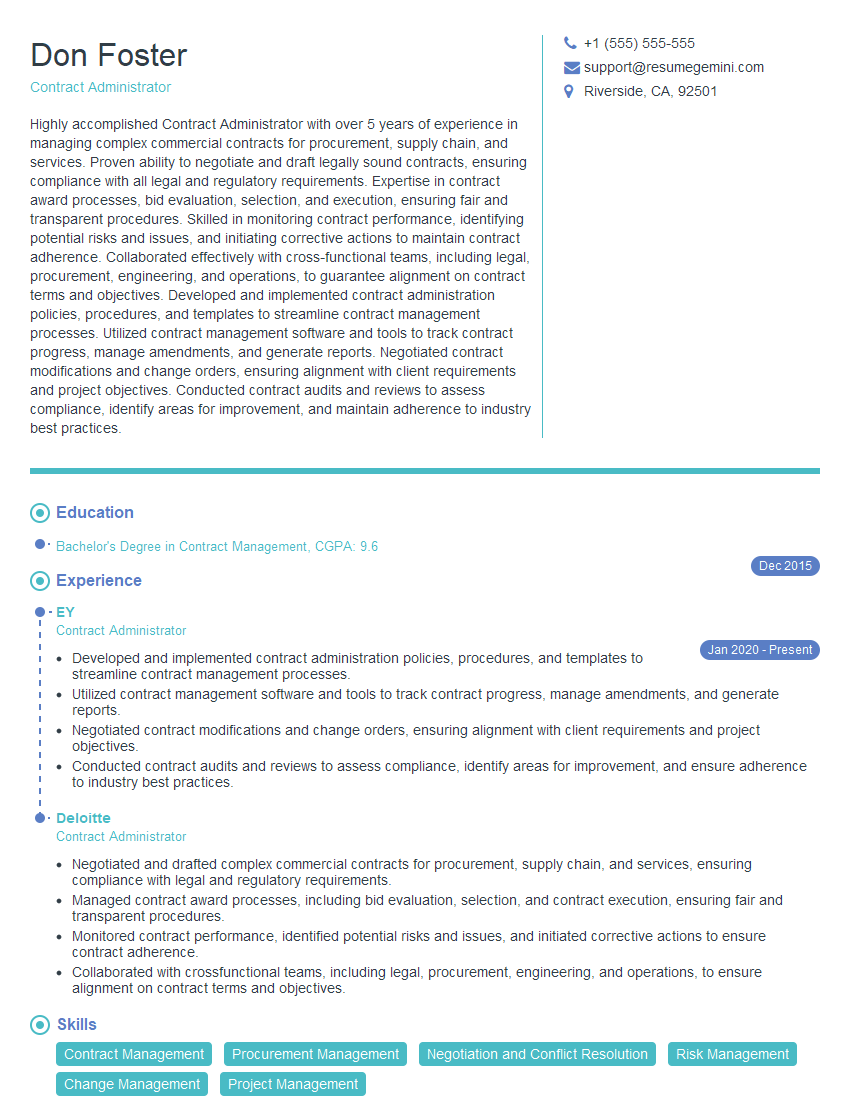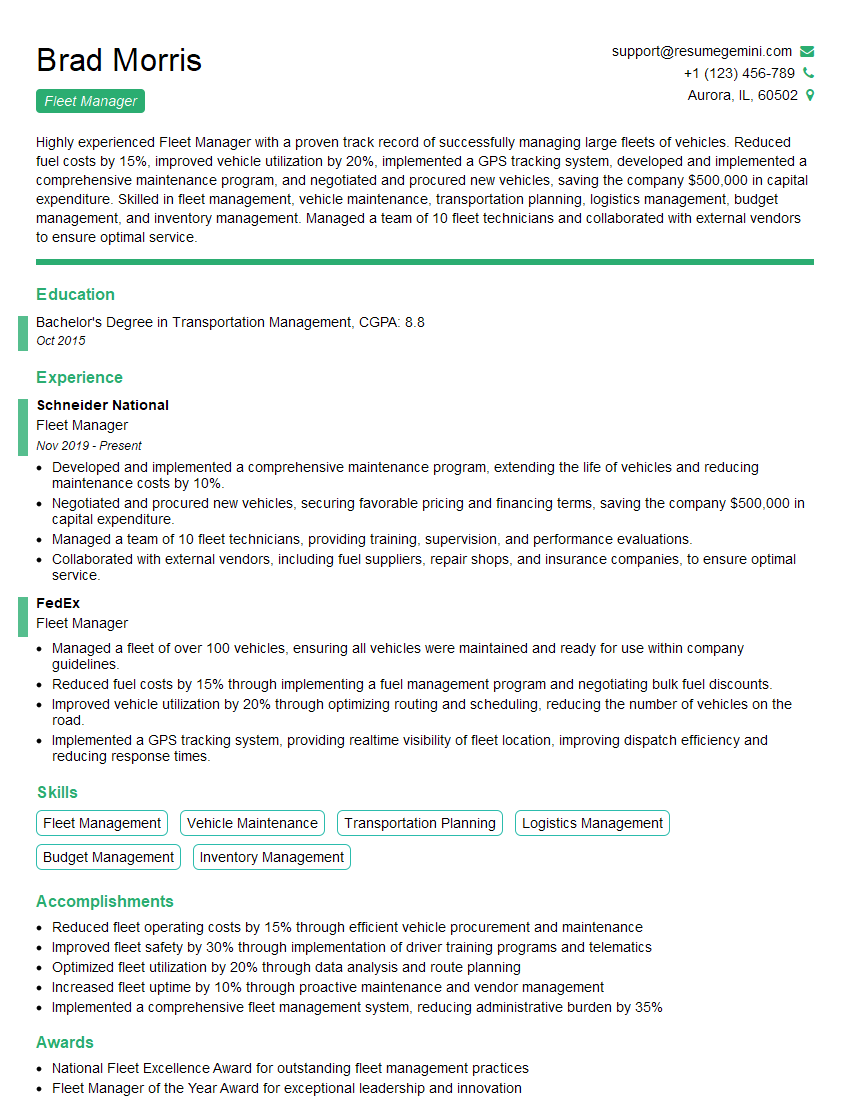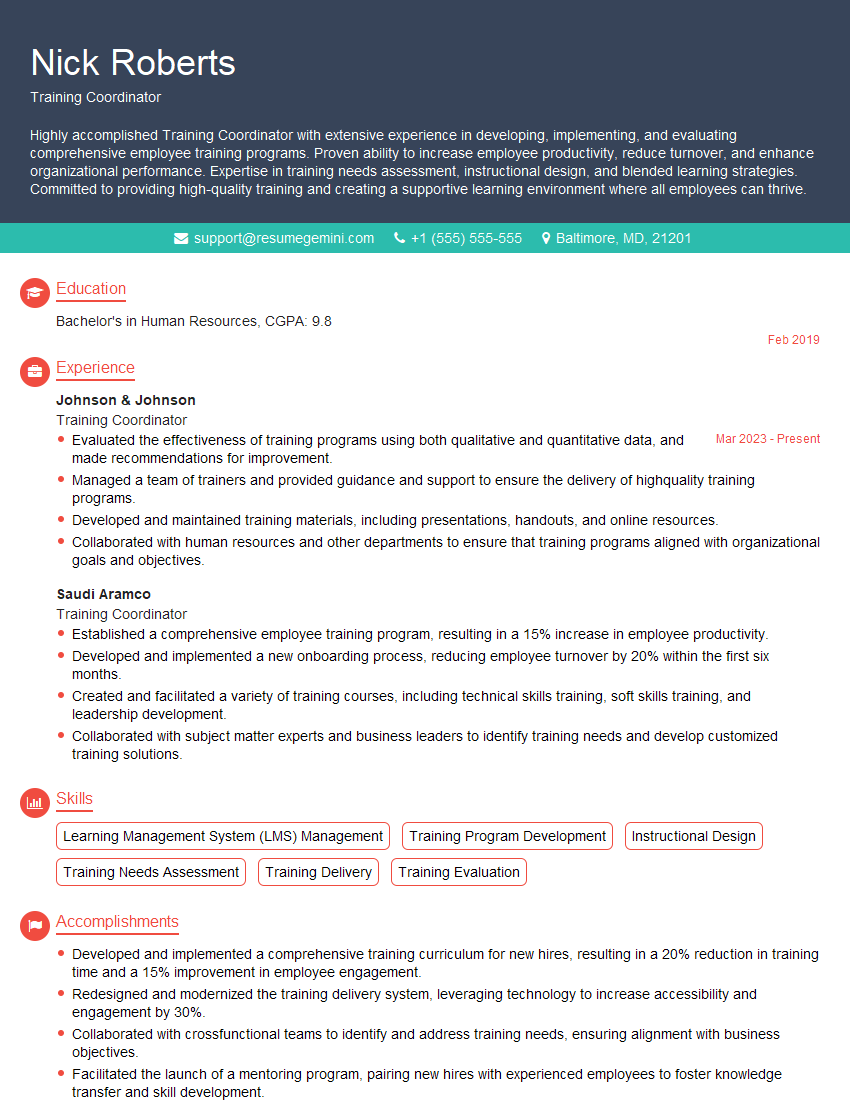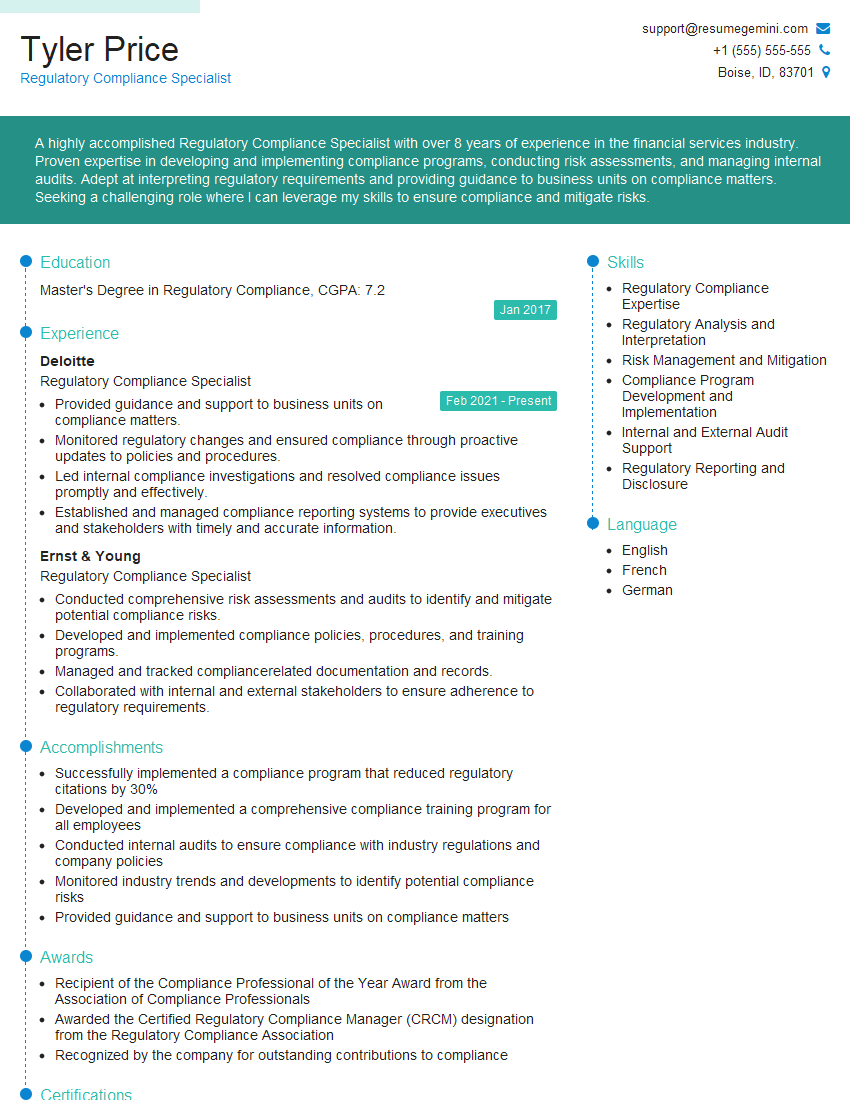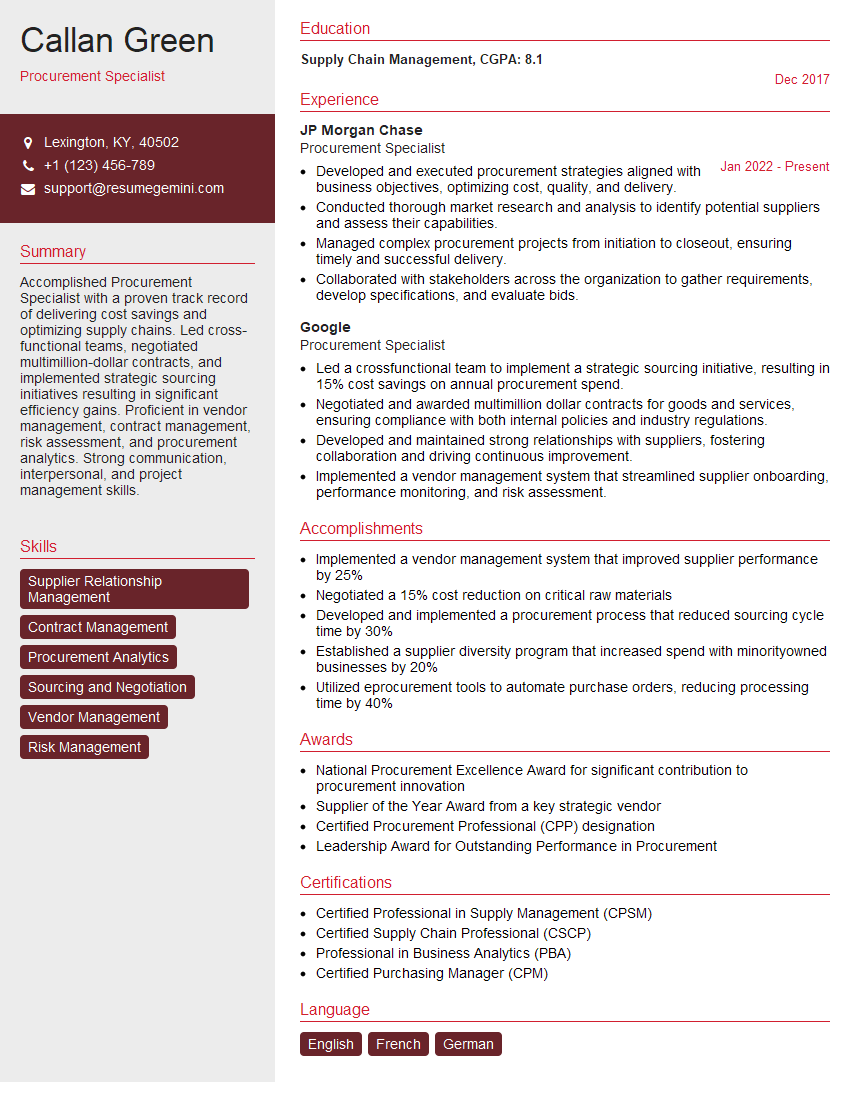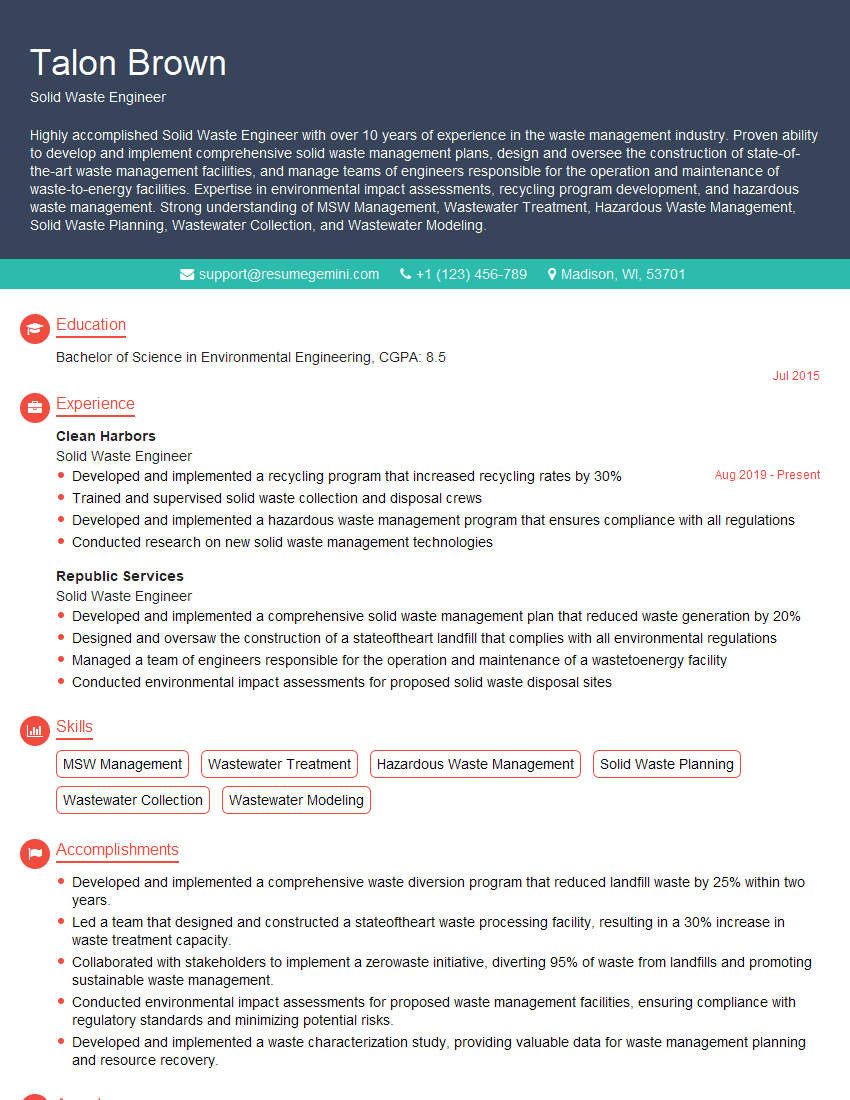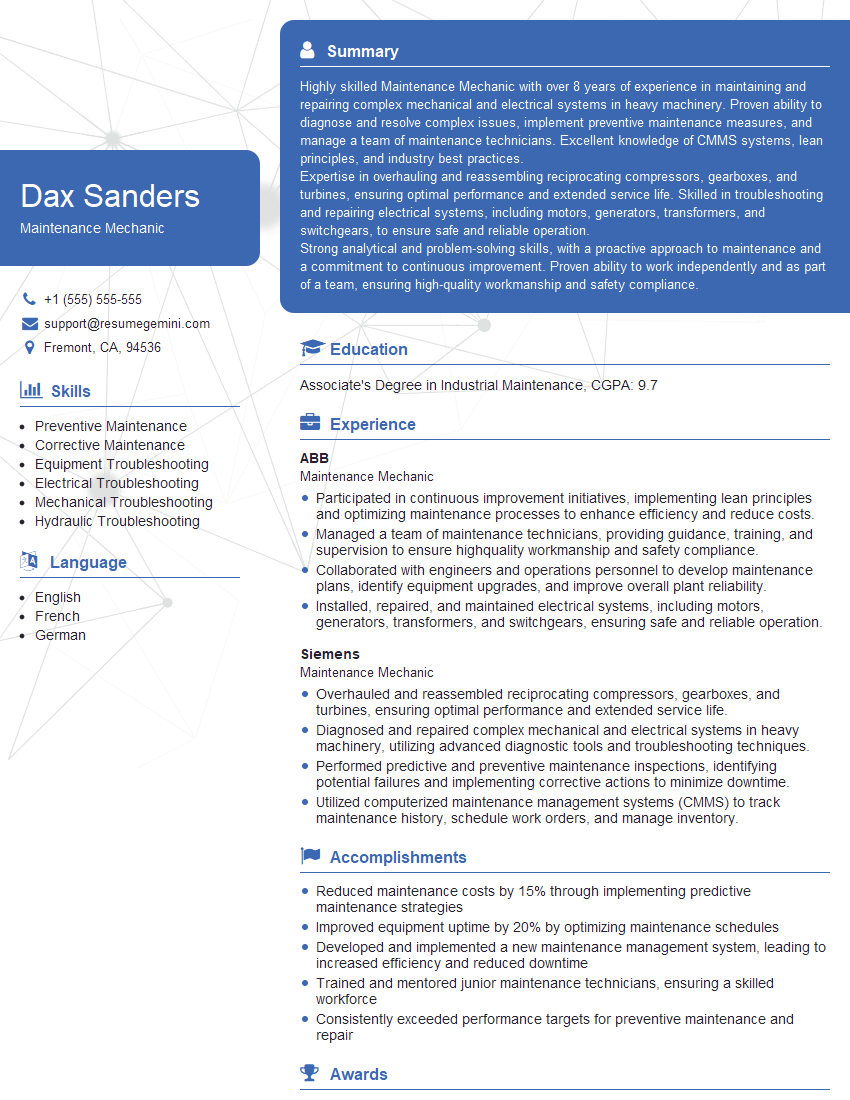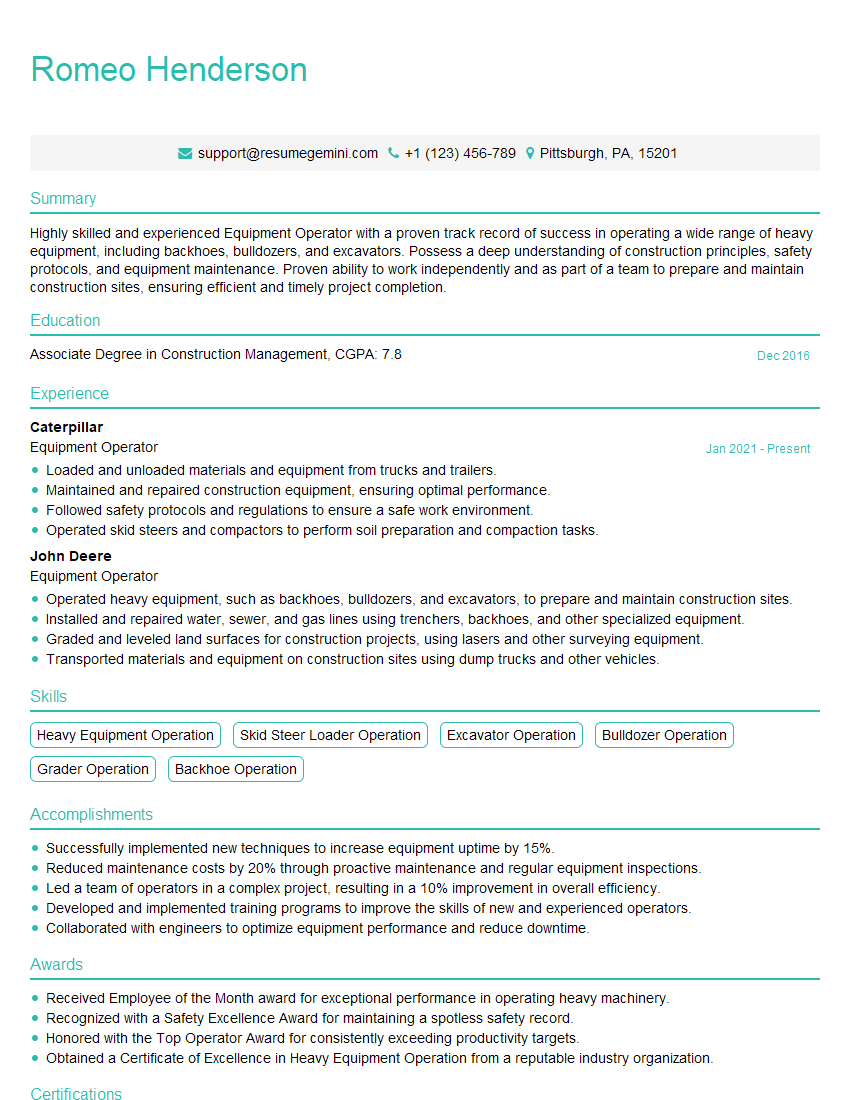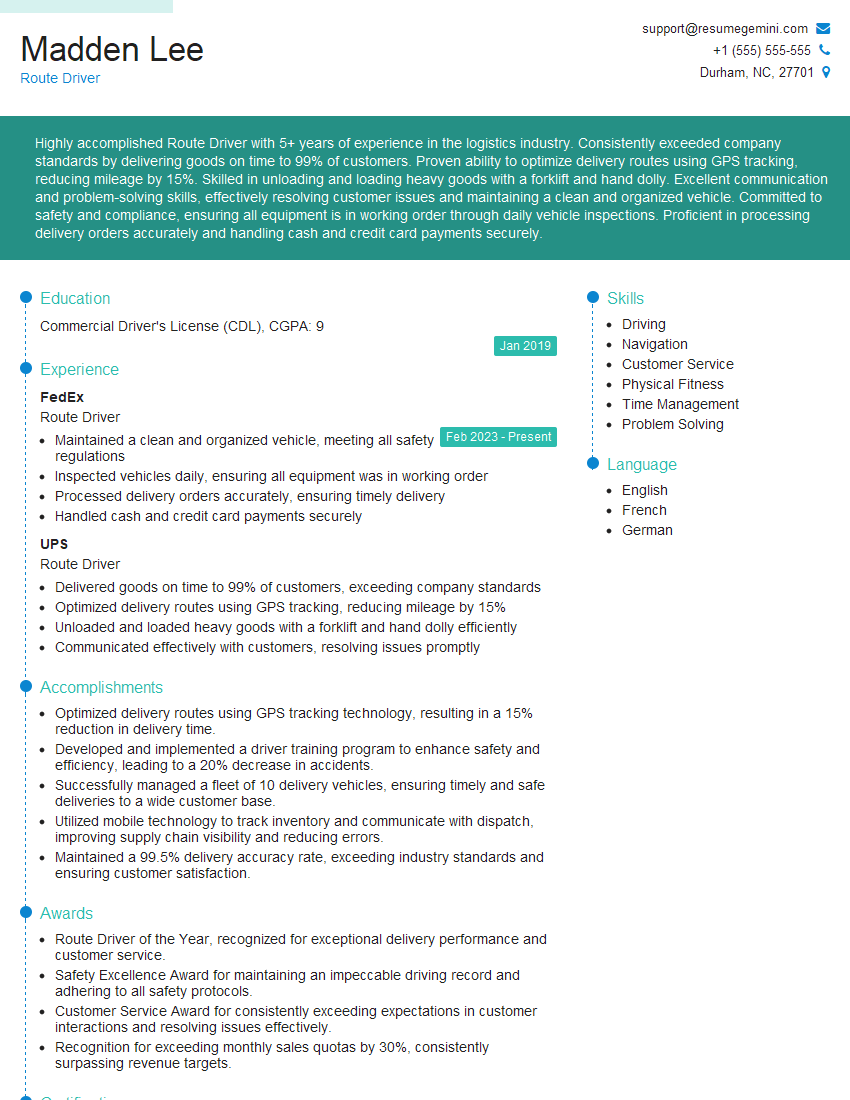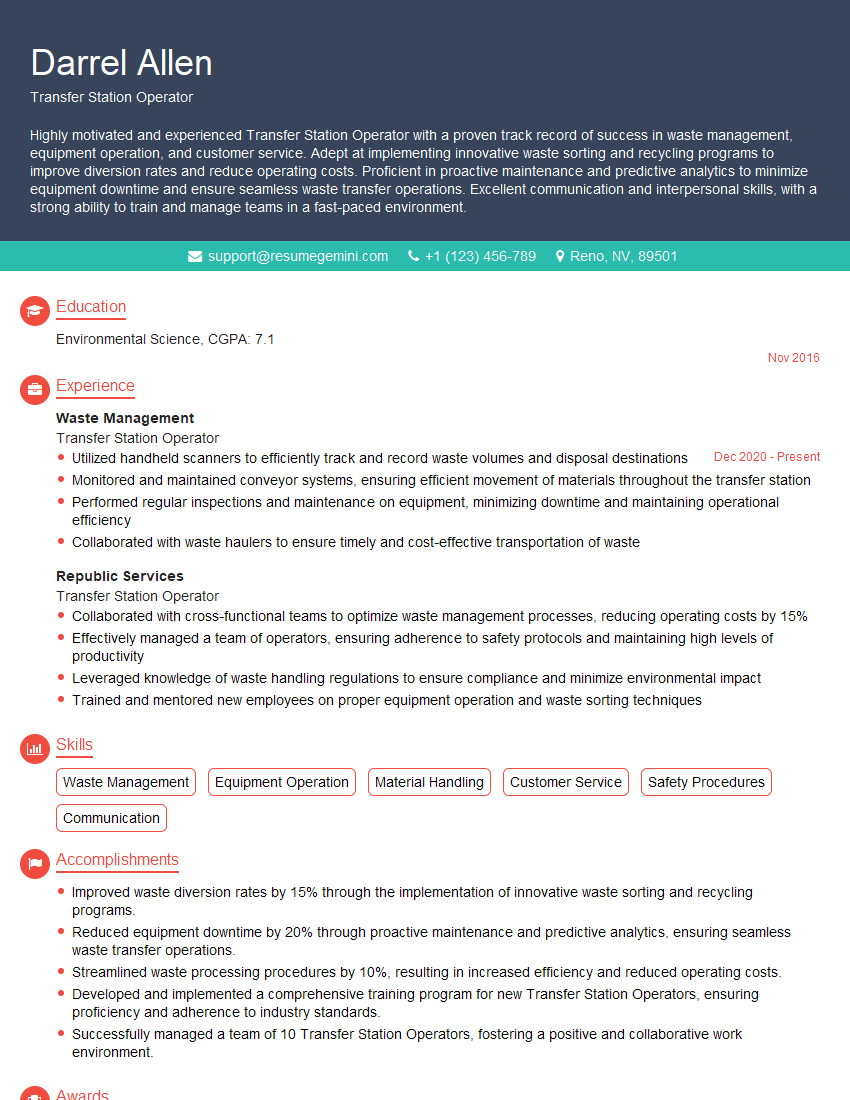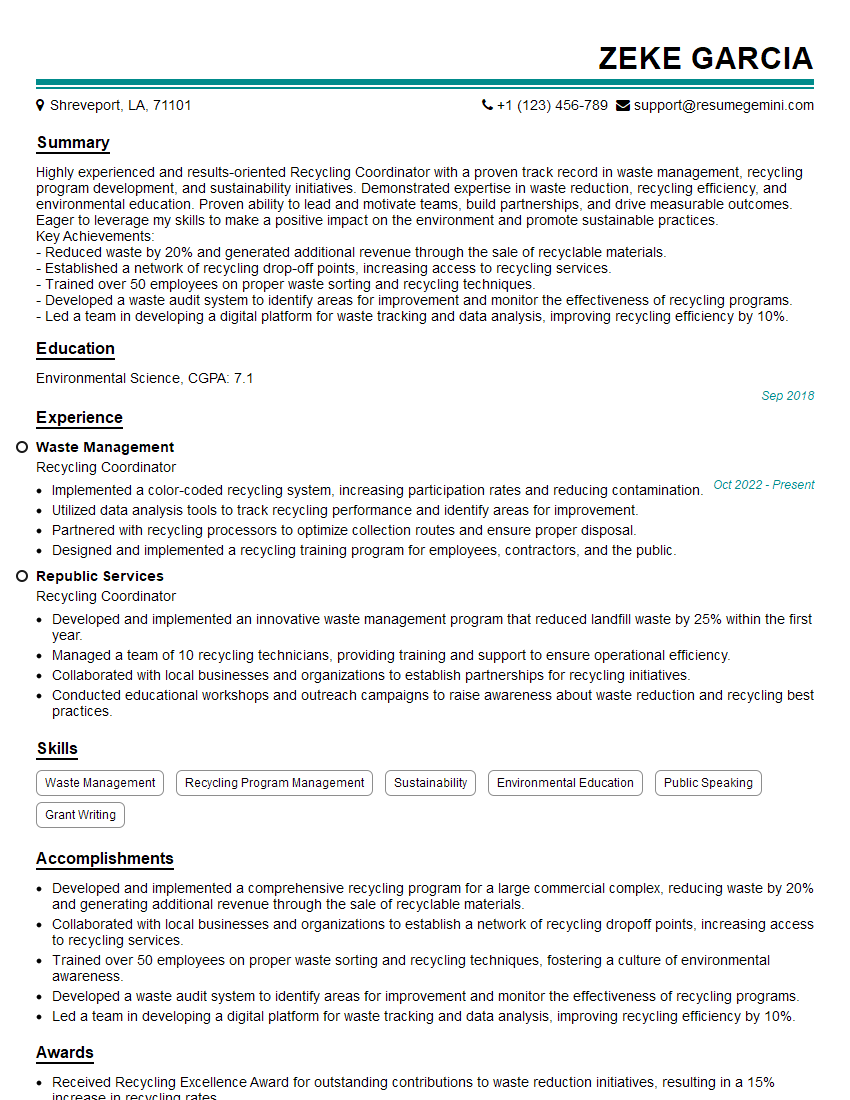Interviews are more than just a Q&A session—they’re a chance to prove your worth. This blog dives into essential Solid Waste Collection interview questions and expert tips to help you align your answers with what hiring managers are looking for. Start preparing to shine!
Questions Asked in Solid Waste Collection Interview
Q 1. Describe your experience with different types of waste collection vehicles.
My experience encompasses a wide range of waste collection vehicles, each suited to specific needs. For residential collection, we primarily use rear-loading trucks, which are efficient for curbside pickup and have large capacity. These are typically automated, using a hydraulic arm to lift and empty bins. For smaller, tighter streets or areas with limited access, we utilize side-loading trucks, offering maneuverability. In commercial settings, where larger volumes are generated, roll-off containers and specialized vehicles such as hooklifts are employed. Hooklifts allow for quick exchange of full containers with empty ones, maximizing efficiency. Finally, we also use compactors for high-density waste, particularly for recyclables, reducing the number of trips to the landfill and enhancing logistics. I’ve worked with both diesel and increasingly, alternative fuel vehicles like CNG (Compressed Natural Gas) and electric trucks, prioritizing environmental responsibility.
Q 2. Explain the process of route optimization for waste collection.
Route optimization is crucial for efficient waste collection. It involves strategically planning the most efficient routes for collection vehicles, minimizing travel time, fuel consumption, and labor costs. This process typically involves using specialized software that considers various factors: the location of all service points (residential homes, businesses, etc.), the volume of waste at each location, the capacity of the collection vehicles, traffic patterns, and even geographical constraints like one-way streets or traffic congestion. The software employs algorithms, often variations of the Traveling Salesperson Problem (TSP), to generate optimal routes. We use a combination of advanced route optimization software with regular field adjustments based on real-time feedback from drivers. For instance, if an unexpected road closure occurs, the software can recalculate routes dynamically, ensuring minimal disruption.
A typical workflow begins with data input (addresses, waste volumes), then route generation and refinement by the software. This is followed by assigning routes to vehicles and drivers. Post-route analysis is key; we regularly review performance data to identify bottlenecks and refine routes for ongoing improvement.
Q 3. How do you ensure the safety of your crew during waste collection operations?
Crew safety is paramount. We implement a multi-pronged approach, starting with comprehensive safety training that covers vehicle operation, manual handling techniques, hazard identification (e.g., sharp objects, traffic), and emergency procedures. Regular safety meetings reinforce best practices and address any emerging concerns. Our vehicles are equipped with backup cameras and audible warning systems to prevent accidents. We provide high-visibility clothing and personal protective equipment (PPE), including gloves, safety boots, and high-visibility vests. Additionally, we maintain a strict policy on pre-trip vehicle inspections to ensure mechanical soundness. Finally, we also integrate technology; using GPS tracking to monitor vehicle location and speed, promoting safer driving practices. We continually analyze accident data to identify trends and implement preventative measures.
Q 4. What are the common challenges faced in managing a solid waste collection fleet?
Managing a solid waste collection fleet presents several challenges. One of the most significant is maintaining a reliable fleet. Regular maintenance and timely repairs are essential to avoid breakdowns and ensure operational efficiency. Another major challenge is driver recruitment and retention; it’s a demanding job that often requires early starts and working in all weather conditions. Fuel costs are also a significant operational expense, hence the growing adoption of alternative fuel vehicles. Navigating traffic and maintaining efficient routes in densely populated areas poses logistical complexities. Finally, adhering to increasingly stringent environmental regulations adds another layer of complexity to operations.
Q 5. Describe your experience with waste transfer stations and their operations.
Waste transfer stations play a crucial role in our operations, acting as intermediaries between collection vehicles and the final disposal sites (landfills or recycling facilities). They consolidate waste from multiple collection routes, increasing efficiency and reducing the number of trips to landfills, thereby lowering transportation costs and environmental impact. Operations at a transfer station involve receiving waste from collection trucks, compacting it into larger containers, and then loading it onto larger haulage vehicles for transport to the disposal site. I’ve been involved in the management and oversight of several transfer stations, focusing on optimizing the flow of waste, ensuring regulatory compliance (weighing, record-keeping), and implementing safety procedures for workers operating heavy machinery.
Q 6. How do you manage and monitor waste collection performance metrics?
We track several key performance indicators (KPIs) to monitor waste collection performance. These include: tonnage collected per route, fuel consumption per ton, service completion rate (percentage of routes completed on schedule), number of missed pickups, driver productivity, and equipment downtime. Data is collected through various means: onboard vehicle computers, GPS tracking systems, manual reporting from drivers, and weighbridge data at transfer stations. This data is analyzed using data analytics tools and dashboards to identify areas for improvement. For example, consistently high fuel consumption on a particular route might indicate a need for route optimization or vehicle maintenance. Similarly, a high number of missed pickups might suggest a need for additional resources or adjustments to the collection schedule. Regular reporting on these KPIs provides a comprehensive overview of our operational efficiency and helps us make data-driven decisions.
Q 7. What are your strategies for handling hazardous waste during collection?
Handling hazardous waste requires specialized procedures and protocols. We have dedicated vehicles and trained personnel for handling hazardous materials, following all relevant safety regulations. Hazardous waste is segregated at its source and stored in clearly labeled containers. We use specialized containers and vehicles designed to prevent spills and leaks. Our drivers and handlers undergo specialized training, which includes knowledge of hazardous waste identification, handling techniques, and emergency response procedures. All handling procedures must adhere strictly to local and national regulations concerning the transportation and disposal of hazardous materials. Detailed documentation is essential and includes manifests tracking the movement of hazardous waste from collection to disposal, ensuring transparency and traceability.
Q 8. Explain your knowledge of waste disposal regulations and compliance.
Waste disposal regulations are complex and vary significantly by location, encompassing federal, state, and local laws. My expertise lies in understanding and adhering to these regulations, which cover aspects like permitted waste types, transportation methods, disposal site requirements, and reporting procedures. Compliance involves meticulous record-keeping, proper labeling of waste containers, ensuring vehicles meet emission standards, and staying updated on changes in legislation. For example, I’m intimately familiar with the Resource Conservation and Recovery Act (RCRA) in the US, which governs hazardous waste management, and the various state-specific regulations that build upon it. Non-compliance can lead to significant fines and legal repercussions, so proactive monitoring and adherence are crucial. I regularly attend industry seminars and leverage online resources to ensure my knowledge stays current.
A key aspect is understanding the different waste classifications – hazardous, non-hazardous, recyclable, and special wastes like medical waste – each with its own unique handling requirements. Failure to classify waste correctly can result in severe penalties and environmental damage. For instance, improper disposal of a hazardous material could contaminate soil and groundwater, posing a severe risk to human health and the environment. My experience includes developing and implementing comprehensive compliance programs that cover all aspects of waste collection, transportation and disposal, ensuring our operations remain legally compliant and environmentally responsible.
Q 9. How do you address customer complaints regarding waste collection services?
Addressing customer complaints is paramount to maintaining positive relationships and service quality. My approach is to treat each complaint as a serious issue requiring prompt and thorough attention. This starts with actively listening to the customer’s concerns, showing empathy, and acknowledging the inconvenience. I utilize a structured process:
- Immediate Acknowledgment: Contact the customer within 24 hours to confirm receipt of their complaint.
- Investigation: Thoroughly investigate the complaint. This might involve reviewing route schedules, speaking with the collection crew, checking vehicle logs, and physically inspecting the location.
- Resolution: Based on the investigation, offer a suitable solution. This could include scheduling a special pickup, providing a replacement bin, offering a partial refund, or explaining the situation clearly.
- Follow-up: Follow up with the customer to ensure they are satisfied with the resolution. This demonstrates our commitment to excellent service.
For example, if a customer reports a missed collection, I would first verify the reported issue, check the driver’s route sheet for any anomalies, then coordinate a swift return visit to collect the waste. Maintaining open communication throughout the process is key, ensuring the customer feels heard and valued. Regular customer feedback surveys also provide valuable insights into areas for improvement.
Q 10. What are your techniques for effective crew management and training?
Effective crew management and training are cornerstones of a successful waste collection operation. This involves establishing clear roles, responsibilities, and performance expectations. I achieve this through:
- Comprehensive Training: New crew members undergo a thorough training program covering safe operating procedures, waste handling techniques, customer service protocols, and the use of equipment. This includes both classroom instruction and on-the-job training under the supervision of experienced team members.
- Regular Meetings: Regular team meetings are held to discuss safety issues, address operational challenges, share best practices, and provide updates on any changes to regulations or procedures. These sessions encourage teamwork and a sense of shared responsibility.
- Performance Monitoring and Feedback: Performance is regularly monitored through observation, route efficiency data, and customer feedback. Regular feedback sessions are provided to both praise good work and identify areas needing improvement. Performance reviews are conducted regularly.
- Incentive Programs: Incentive programs, such as safety awards or bonuses based on performance metrics, can boost morale and promote a culture of excellence.
For instance, we might use route optimization software to analyze collection efficiency and identify areas for improvement. A strong safety culture, with regular safety talks and training on equipment operation, is non-negotiable, to ensure worker well-being and minimizing accidents.
Q 11. How do you handle unexpected events or equipment malfunctions during a route?
Unexpected events, like equipment malfunctions or accidents, require a swift and organized response to minimize disruption. My approach involves:
- Immediate Assessment: Quickly assess the situation to understand the nature and extent of the problem. This involves determining the safety risks, the potential impact on the route, and the resources needed to resolve the issue.
- Emergency Protocol Activation: Activate pre-established emergency protocols, including notifying supervisors, dispatching backup vehicles or crews, and securing the affected area.
- Communication: Maintain open communication with supervisors, dispatch, and affected customers to keep everyone informed of the situation and the plan for resolution.
- Problem Solving: Work collaboratively to find effective solutions, such as temporarily rerouting collections, repairing equipment on-site, or coordinating alternative transportation for the waste.
- Post-Incident Review: After the event, a thorough review is conducted to analyze the cause of the incident, identify lessons learned, and implement preventative measures to minimize the likelihood of similar incidents in the future. This might involve equipment maintenance scheduling improvements, revising operational procedures or strengthening emergency response protocols.
For example, if a garbage truck breaks down mid-route, I’d immediately initiate a contingency plan – contacting dispatch to send a replacement truck, informing affected customers of a potential delay, and ensuring the safety of the crew until the replacement arrives.
Q 12. Describe your experience with different waste sorting and recycling methods.
I have experience with a variety of waste sorting and recycling methods, ranging from manual sorting at material recovery facilities (MRFs) to automated systems using advanced technologies. Manual sorting is labor-intensive but allows for high-quality separation of various recyclable materials. Automated systems employ technologies like optical sorters and eddy current separators to identify and sort materials based on their physical and chemical properties, increasing efficiency and reducing contamination.
My experience includes working with single-stream recycling programs, where all recyclable materials are collected together and then sorted at a MRF, as well as dual-stream systems where recyclables are separated into paper/cardboard and containers streams at the point of collection. I also have practical experience in implementing source-separated collection programs, which involve different bins for different materials at the household level, resulting in higher quality recyclables. Understanding the pros and cons of each method – considering factors like cost, efficiency, and environmental impact – is vital for selecting the most appropriate approach for a given community. Furthermore, I am familiar with composting methods for organic waste and anaerobic digestion for generating biogas from food waste. The choice depends on local infrastructure, community participation, and overall sustainability goals.
Q 13. How do you ensure the proper disposal of medical or biohazardous waste?
The proper disposal of medical or biohazardous waste is critical to protect public health and the environment. This requires strict adherence to regulations and specialized handling procedures. This includes using clearly marked, leak-proof containers for the segregation and storage of medical waste, following specific transportation requirements (often using dedicated vehicles), and ensuring disposal at licensed facilities equipped to handle such materials. These facilities often use autoclaves for sterilization before final disposal or incineration.
My experience involves working with licensed medical waste disposal contractors who meet all regulatory requirements and maintain detailed records of the waste stream. We ensure our staff receive specialized training in handling medical waste, including proper use of personal protective equipment (PPE) to minimize the risk of exposure. This process incorporates the careful tracking of waste from generation to final disposal and complete documentation of all steps. Any incident involving a potential exposure is reported immediately to the appropriate authorities and addressed with utmost caution, following strict protocols for decontamination and employee protection.
Q 14. What are your strategies for minimizing environmental impact during waste collection?
Minimizing the environmental impact of waste collection is a high priority. My strategies focus on:
- Route Optimization: Using GPS technology and route optimization software to minimize fuel consumption and reduce vehicle emissions.
- Fuel-Efficient Vehicles: Utilizing fuel-efficient vehicles and exploring alternative fuel options like compressed natural gas (CNG) or electric vehicles.
- Recycling and Waste Reduction Programs: Promoting recycling and waste reduction programs to decrease the overall volume of waste collected.
- Employee Training: Training employees on environmentally responsible driving practices and waste handling techniques.
- Partnerships: Collaborating with local organizations and recycling facilities to enhance recycling efforts and explore sustainable disposal solutions.
- Regular Maintenance: Maintaining all vehicles and equipment to optimize their performance and reduce emissions.
For instance, we’d analyze our collection routes to identify inefficiencies and consolidate routes, reducing travel time and fuel consumption. Regular maintenance checks on our fleet ensure that vehicles operate at peak efficiency, minimizing their environmental footprint. The adoption of electric waste collection vehicles is a long-term goal, aligning with the increasing need for sustainability in this sector. Continuous assessment and improvements are essential for a constantly evolving and impactful environmental strategy.
Q 15. Explain your experience with GPS tracking and route management software.
GPS tracking and route optimization software are indispensable tools in modern waste collection. My experience spans several years using systems like Route4Me and EasyRoute, which allow for real-time monitoring of vehicle locations, dynamic route adjustments based on traffic or unforeseen circumstances, and detailed performance analysis.
For instance, in a previous role, we used GPS data to identify areas where collection times were consistently exceeding the norm. This analysis revealed a bottleneck caused by increased residential density in a newly developed neighborhood. By adjusting the route and adding an extra crew to that specific area, we were able to significantly reduce delays and improve overall efficiency.
These systems typically integrate with mobile devices in garbage trucks, enabling drivers to receive real-time updates, report issues (like blocked access or overflowing bins), and confirm service completion, all of which contributes to improved data accuracy and customer satisfaction.
Career Expert Tips:
- Ace those interviews! Prepare effectively by reviewing the Top 50 Most Common Interview Questions on ResumeGemini.
- Navigate your job search with confidence! Explore a wide range of Career Tips on ResumeGemini. Learn about common challenges and recommendations to overcome them.
- Craft the perfect resume! Master the Art of Resume Writing with ResumeGemini’s guide. Showcase your unique qualifications and achievements effectively.
- Don’t miss out on holiday savings! Build your dream resume with ResumeGemini’s ATS optimized templates.
Q 16. How do you maintain accurate records of waste collection activities?
Maintaining accurate waste collection records is crucial for operational efficiency, regulatory compliance, and billing accuracy. We employ a multi-pronged approach leveraging both manual and automated systems. Manual records include pre-trip vehicle inspections, driver manifests detailing completed pickups, and daily summary reports of collected tonnage. This is often supplemented with barcode scanning of bins to verify service and improve data quality.
Automated systems, such as those integrated with GPS tracking software, automatically log pick-up times, locations, and volume data. This data is then uploaded to a central database, where it’s used for generating reports, analyzing performance, and identifying potential areas for improvement. For instance, we can use this data to analyze trends in waste generation based on time of year, location, and type of waste, which informs strategies like public education campaigns or optimized collection schedules.
Regular audits are conducted to ensure data accuracy and consistency across all records, comparing data from manual and automated systems for discrepancies. This ensures the information we use for decision-making is reliable and trustworthy.
Q 17. Describe your experience with waste collection in different weather conditions.
Waste collection is a year-round operation, regardless of weather. Experience has taught me the importance of adapting strategies to different conditions. In heavy snow or ice, for example, we prioritize main roads and areas with higher traffic density to ensure safe access for emergency vehicles. We also use specialized equipment like snowplows and salt spreaders to clear pathways.
During extreme heat, driver safety is paramount. We adjust work schedules to avoid peak sun hours, provide adequate hydration and rest breaks, and implement heat-safety protocols. Similarly, heavy rain requires caution, with drivers being mindful of potential flooding and hazardous road conditions.
Predictive weather modelling is crucial. We proactively adjust routes and schedules based on forecasts, potentially delaying less critical pickups in anticipation of severe weather. This minimizes disruptions and ensures the safety of our crews. Regular safety training ensures our staff are prepared to respond effectively to any challenging weather event.
Q 18. How do you prioritize routes and handle emergencies effectively?
Prioritizing routes is a critical aspect of efficient waste collection. We typically use a combination of factors, including route length, waste volume, service frequency, and time-sensitive pickups (e.g., medical waste). Advanced route optimization software plays a significant role, automatically generating efficient routes based on these parameters. This ensures that we collect the most waste in the shortest possible time.
Handling emergencies, such as equipment malfunctions, blocked access, or unexpected spillage, requires a swift and organized response. Our procedures involve immediate communication to dispatch using two-way radios or mobile apps, followed by rerouting affected areas, mobilizing backup equipment if necessary, and ensuring the safety of the public and crew. Clear communication among drivers, supervisors, and dispatch is essential to resolve the emergency effectively and minimize disruption to the remaining schedule.
Q 19. What are your strategies for improving efficiency and reducing costs in waste collection?
Improving efficiency and reducing costs in waste collection requires a multifaceted strategy. Optimized routing, as discussed earlier, is key. This is often combined with implementing fuel-efficient driving techniques and regular vehicle maintenance to minimize fuel consumption.
Another area for improvement is waste reduction at the source. Educational campaigns targeting residential and commercial waste generators can significantly reduce overall waste volume, decreasing collection frequency and lowering transportation costs. We can also explore opportunities for recycling and composting programs which reduce landfill waste and generate revenue streams.
Data analytics plays a critical role. Analyzing data on waste generation, collection times, and equipment performance helps identify areas for improvement and optimization. For example, identifying areas with unusually high waste generation might indicate a need for additional bins or changes in collection frequency.
Investing in new technology, such as automated collection vehicles or smart bins, can further enhance efficiency and reduce labor costs in the long run.
Q 20. How do you communicate effectively with various stakeholders (customers, supervisors, crews)?
Effective communication is the cornerstone of successful waste management operations. With customers, clear and consistent communication regarding schedules, service disruptions, and billing is crucial. We achieve this through a variety of methods, such as automated notifications (e.g., text messages, email alerts), online portals for account management, and readily available customer service channels.
Internal communication is equally important. We use two-way radios, mobile apps, and daily briefings to keep crews informed of route changes, potential hazards, and operational updates. Supervisors maintain regular contact with drivers, providing support and addressing concerns promptly. Regular team meetings foster open communication and feedback.
Transparency and clear reporting procedures are key when communicating with supervisors. We provide regular updates on performance metrics, potential problems, and safety incidents, enabling proactive problem-solving and resource allocation. Open feedback mechanisms ensure that all stakeholders are heard and that potential issues are identified and addressed quickly.
Q 21. Explain your understanding of waste disposal facility regulations.
Understanding waste disposal facility regulations is crucial for compliance and responsible environmental stewardship. My knowledge covers a range of regulations, including those related to waste characterization (hazardous vs. non-hazardous), landfill capacity limits, environmental monitoring requirements (like leachate and groundwater), and permit requirements for waste disposal facilities.
I am familiar with relevant legislation at both state and federal levels, including regulations concerning the handling of specific waste streams, such as medical waste, construction debris, and hazardous materials. Compliance is not just about avoiding penalties but also about protecting public health and the environment.
This includes knowledge of manifest systems for tracking waste movement from point of generation to disposal, understanding environmental reporting requirements (e.g., waste characterization reports, landfill gas monitoring data), and staying updated on changes in regulations. Regular training and participation in industry events help maintain this up-to-date knowledge base.
Q 22. How do you handle situations involving overflowing bins or missed collections?
Overflowing bins and missed collections are serious issues impacting both sanitation and public perception. My approach is proactive and multi-faceted. First, we utilize route optimization software to identify potential problem areas and adjust schedules as needed. This predictive approach is key to preventing issues before they arise. For instance, during peak seasons like holidays, we anticipate higher waste generation and preemptively increase collection frequency in densely populated areas.
Secondly, we have a robust reporting system. Citizens can report missed collections or overflowing bins directly through a mobile app or online portal. This information immediately triggers an alert to our dispatch team. We prioritize these reports, sending a crew to address the issue within a specified timeframe – typically within 24 hours, depending on urgency and location. We also conduct regular route checks to identify any issues not reported by the public.
Finally, communication is paramount. We update residents through the app and our website about any unforeseen delays, explaining the reasons and expected resolution times. Transparency builds trust and minimizes frustration. In the event of recurring issues with a specific bin, we investigate the root cause, such as incorrect bin placement, excessive waste generation, or damage to the bin itself.
Q 23. Describe your experience with waste audits and assessments.
Waste audits and assessments are critical for optimizing collection routes, resource allocation, and promoting recycling. My experience encompasses both residential and commercial settings. We’ve used several methodologies including manual sorting, where we physically sort through a sample of waste to determine its composition, and automated analysis using optical sorters to quickly categorize large volumes of waste.
The data we collect through these audits provides invaluable insights. For example, we recently conducted a waste audit that revealed a surprisingly high percentage of recyclable materials in the general waste stream. This prompted us to launch a targeted public awareness campaign emphasizing proper sorting techniques and the benefits of recycling. The campaign resulted in a significant increase in recycling rates and a decrease in landfill waste, leading to cost savings and a reduced environmental impact.
Beyond composition analysis, waste audits also help us assess the efficiency of our collection routes. We analyze data on collection times, vehicle mileage, and the volume of waste collected to identify inefficiencies and optimize our operations. For instance, we identified a route where collection times were consistently high. A subsequent analysis revealed a bottleneck caused by limited access in a particular neighborhood. By working with the local authorities to improve road access, we reduced collection time and improved overall efficiency.
Q 24. How do you maintain a safe and productive work environment for your crew?
Maintaining a safe and productive work environment for my crews is my top priority. This requires a multi-pronged approach focusing on safety training, equipment maintenance, and fostering a positive team culture. All new hires undergo comprehensive safety training covering topics like proper lifting techniques, hazard identification, and the safe operation of collection vehicles and equipment.
Regular safety meetings are held to address potential hazards, review accident prevention strategies, and provide updates on safety regulations. We also equip our crews with personal protective equipment (PPE) including high-visibility vests, gloves, and safety boots. Furthermore, our vehicles are meticulously maintained to ensure they are in optimal working condition and meet all safety standards.
Beyond physical safety, we also prioritize mental wellbeing. Open communication is encouraged, fostering a team environment where employees feel comfortable raising concerns and providing feedback. We provide access to employee assistance programs and promote work-life balance. A safe and supportive work environment leads to improved morale, reduced employee turnover, and increased productivity. A happy and healthy team is a productive team.
Q 25. What is your experience with waste reduction and recycling programs?
My experience with waste reduction and recycling programs is extensive. I’ve been involved in the design, implementation, and evaluation of numerous programs across various communities. This involves collaborating with local governments, businesses, and community organizations to promote environmentally sustainable waste management practices.
One successful program I implemented involved introducing a curbside composting system. Prior to its implementation, organic waste made up a substantial portion of the landfill waste stream. The composting program diverted this organic material, reducing landfill volume and creating a valuable soil amendment. This program was successful because of a concerted effort in community outreach and education, providing residents with clear guidelines and addressing concerns.
Furthermore, I’ve worked on initiatives to increase recycling rates by providing residents with clear instructions on what materials can be recycled, using different color-coded bins for different waste streams. This makes sorting easier, while public awareness campaigns and educational materials reinforce the importance of responsible waste management. We’ve also partnered with local businesses to implement source reduction and recycling programs at their facilities, generating positive environmental and economic benefits.
Q 26. Explain your knowledge of different types of waste containers and their applications.
A thorough understanding of different waste containers and their applications is crucial for efficient waste management. We utilize a variety of containers tailored to specific waste streams and collection methods. Common types include:
- Residential bins (wheelie bins): These are the standard bins used for curbside collection, typically ranging in size from 120 to 240 gallons. Their size and design are optimized for ease of handling and automated collection.
- Commercial dumpsters: Larger containers, ranging from several cubic yards to several tens of cubic yards, used by businesses and institutions to dispose of larger volumes of waste. Different sizes cater to the specific needs of each business.
- Recycling bins: Often color-coded to distinguish between different recyclable materials (e.g., paper, plastic, glass, metal). These bins are strategically placed in public areas and residential settings.
- Specialized containers: Containers are used for specific waste streams such as hazardous waste, medical waste, and construction and demolition debris. These containers are designed with safety features to prevent leaks and contain hazardous materials.
The selection of appropriate containers is based on factors such as waste generation volume, the type of waste being collected, and the efficiency of the collection process. For instance, using smaller bins in high-density residential areas promotes easier handling and minimizes space constraints. Whereas larger dumpsters would be more suitable for businesses that generate significant quantities of waste.
Q 27. How do you adapt to changes in waste collection regulations or technology?
Adaptability is key in the dynamic world of waste collection. Changes in regulations and technology necessitate continuous learning and adjustment. We proactively monitor updates to environmental regulations, attending industry conferences and workshops to remain informed. For example, changes in recycling standards or the introduction of new recyclable materials require us to update our collection protocols and public education materials.
Technology plays a significant role, and we actively incorporate new technologies into our operations. This includes utilizing route optimization software, GPS tracking for our vehicles, and automated data collection systems. Implementing smart bins with sensors that monitor fill levels allows for more efficient scheduling and reduces the need for unnecessary trips. By embracing technological advancements, we can achieve greater efficiency, reduce operational costs, and improve service quality.
Furthermore, we engage in continuous improvement efforts. Regular review of our operations, combined with feedback from both our crews and residents, enables us to identify areas for optimization and adaptation. We embrace a culture of continuous learning, viewing change not as a threat, but as an opportunity to enhance our services and improve environmental performance.
Q 28. Describe your experience with budget management and resource allocation in waste collection.
Budget management and resource allocation are crucial for the successful operation of a waste collection service. My experience includes developing and managing budgets, allocating resources effectively, and tracking expenditures to ensure cost-effectiveness and compliance.
We use a combination of forecasting models and historical data to create accurate budget projections. These projections consider factors such as fuel costs, labor costs, maintenance expenses, and the volume of waste collected. This enables us to accurately estimate our expenses and plan accordingly. Resource allocation involves distributing the budget strategically across various operational areas including vehicle maintenance, personnel training, and equipment purchases.
We also use data analytics to identify cost-saving opportunities. For instance, analyzing fuel consumption data helped us implement a more efficient routing system, leading to significant fuel savings. Similarly, using data to track equipment maintenance schedules helps to prevent costly breakdowns and extends the lifespan of our vehicles. Regular budget reviews and performance monitoring ensures transparency and accountability, allowing for timely adjustments and informed decision-making. We strive to balance fiscal responsibility with environmental sustainability, ensuring efficient and cost-effective waste collection while minimizing our environmental impact.
Key Topics to Learn for Solid Waste Collection Interview
- Route Optimization and Efficiency: Understanding principles of efficient route planning, including factors like traffic patterns, geographical constraints, and waste volume distribution. Practical application: Explain how you would optimize a route to minimize fuel consumption and maximize collection efficiency.
- Waste Management Regulations and Compliance: Knowledge of local, state, and federal regulations regarding waste disposal, hazardous waste handling, and environmental protection. Practical application: Describe how you would ensure compliance with all relevant regulations during daily operations.
- Vehicle Maintenance and Safety: Understanding the mechanics of garbage trucks, preventative maintenance procedures, and safe operating practices. Practical application: Explain how you would troubleshoot a minor mechanical issue to minimize downtime and ensure safety.
- Waste Collection Equipment and Technology: Familiarity with various types of collection equipment, including automated side loaders, rear loaders, and roll-off containers. Explore the use of GPS tracking and other technological advancements in waste management. Practical application: Discuss the advantages and disadvantages of different collection technologies.
- Customer Service and Communication: Skills in handling customer inquiries, addressing complaints, and maintaining positive relationships with residents and businesses. Practical application: Describe a situation where you successfully resolved a customer complaint related to waste collection.
- Health and Safety Procedures: Understanding and adhering to safety protocols to prevent workplace injuries, including proper lifting techniques, use of personal protective equipment (PPE), and hazard identification. Practical application: Explain how you would ensure the safety of yourself and your crew during a challenging collection scenario.
- Waste Stream Analysis and Reduction: Understanding the composition of waste streams and strategies for waste reduction and recycling programs. Practical application: Discuss how you would contribute to initiatives aimed at diverting waste from landfills.
Next Steps
Mastering the intricacies of Solid Waste Collection opens doors to a rewarding career with opportunities for advancement and specialization. A strong understanding of these concepts will significantly boost your interview performance and secure your desired position. To enhance your job prospects, focus on crafting an ATS-friendly resume that effectively highlights your skills and experience. We strongly recommend using ResumeGemini, a trusted resource for building professional resumes. ResumeGemini provides examples of resumes tailored to the Solid Waste Collection industry to help you create a compelling application that stands out from the competition.
Explore more articles
Users Rating of Our Blogs
Share Your Experience
We value your feedback! Please rate our content and share your thoughts (optional).

